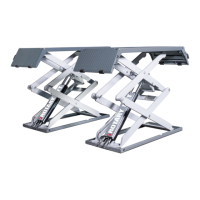10
2. Safety
2.1 Operators
The scissor lift may only be operated without
supervision by persons who:
• Are 18 years old and above.
• Are familiar with the basic regulations on health &
safety and accident prevention.
• Have been trained to handle and operate the
scissor lift.
• Have proven their ability to do so to the company.
• Have been expressly appointed in writing to ope-
rate the lift.
• Have read and understood the operating manual.
2.2 Basic safety requirements
• Only operate the scissor lift after a specialist
has cetied in the inspection log that it has been
correctly set up.
• Always follow the operating instructions (labels on
the scissor lift).
• If several people work on the scissor lift, a
supervisor must be appointed by the company.
• The scissor lift may only be operated in
technically sound condition with regard to safety
and with all safety mechanisms in place.
• The control box or control unit may only be open-
ed by a qualied electrician.
• Safety inspections must be conducted regularly,
at least once annually.
• If signs of a defect appear, immediately shut
down the scissor lift, inform a supervisor and
contact the customer service if necessary.
• Keep the work area clean and free of oil, grease,
and contamination.
• Before lifting/lowering, check that the acoustic
alarm (buzzer) works.
• There must be no obstacles in the path of the
scissor lift .
• Always monitor the load carefully when lifting and
lowering.
• Always stop the vehicles safely, centered on the
platforms.
• Always lift the vehicle on the pick-up points
approved by the vehicle manufacturer. Lift it for a
short distance and check that the pick-up points
are secure. Only then can the vehicle be moved
to the required height.
• Take steps against trafc in the area of the
scissor lift. Do not park other vehicles in the
danger zone.
• Do not load lifts beyond the permitted capacity,
comply with the permitted axle loads and load
distribution in accordance with Chapter 2.3.
• When disassembling or tting heavy vehicle
parts, watch out for dangerous shifts in the
weight balance, in particular when the vehicle
is supported by lifting table. Secure the vehicle
beforehand.
• Always fully lower, switch off and secure scissor
lift to prevent unauthorized use after completion
of work (turn main switch to "OFF“ and lock).
• Follow the maintenance and service schedule,
record performance of maintenance and servicing
(Chapter 9).
• Installation, maintenance and servicing may
only be carried out by authorized specialists
(maintenance contractors) (Chapter 9).
• Only qualied electricians may work on the elec-
trics.
• Only trained people with knowledge of hydraulics/
pneumatics may work on hydraulic or pneumatic
equipment.
• Appropriate personal protective equipment
must be worn when working in the area of the
lift in accordance with the applicable health &
safety and accident prevention regulations. For
example, protective gloves, protective goggles,
safety shoes.
• Only original spare parts from the manufacturer
may be used.
• The lift must be inspected by a specialist after
repairing any supporting parts.
2.3 Permitted axle loads and weight
distribution
Before lifting the vehicle, you must ensure that
the weight distribution is correct.
When the weight distribution is correct (default
position in direction of motion) the main load is
located at the front (e. g. engine).

